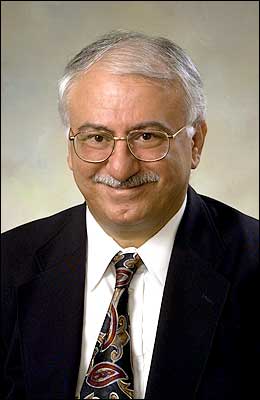Biographical Information: Dr. Mohsen Kavehrad, is the Founder of The Center for Research in Knowledge Communications (CRKC). He received his Ph.D. degree from Polytechnic Institute of New York University (NYU) in 1978 in Electrical Engineering. Between 1978 and 1981, he worked for Fairchild Industries (Space Communications Division) and GTE (Satellite Corp. and Labs.). He then joined Bell Laboratories where he worked on communications and networking research problems. After the breakup of the Bell System, he was invited to join the Department of Electrical Engineering at University of Ottawa, as a Full Professor in March 1989. He was also the Director of Photonic Networks and Systems Thrust and a project leader in the Telecomm. Research Institute of Ontario (TRIO) and the Director of Ottawa-Carleton Communications Center for Research (OCCCR). He was an invited academic visitor (senior technical consultant) at NTT Laboratories, Japan, in summer 1991. He spent a six months sabbatical term as an invited academic visitor (senior technical consultant) at NORTEL, Ottawa, in 1996. In January 1997, he was invited to join the Department of Electrical Engineering, Pennsylvania State University - University Park, PA. as the first W.L. Weiss Endowed Chair Professor of Electrical Engineering. In August 1997, he was appointed as the founding Director of Center for Information and Communications Technology Research (CICTR). During 1997-98, he was also invited to be the CTO and Vice President at Tele-Beam Inc., State College, PA. He spent a six months sabbatical term as an - invited by the CTO - academic visitor (senior technical consultant) at AT&T Shannon Research Labs., Florham Park, New Jersey, in 2004. Finally, Dr. Kavehrad retired from The Pennsylvania State University on June 30, 2017. He has served as a consultant to a score of major corporations and government agencies. His research contributions have been in the fields of; Satellite communications, fixed point-to-point radio communications, Portable and Mobile radio communications, Atmospheric Laser communications, Fiber optic communications, Fiber optic networks and Knowledge Communications. His current research interests are aligned with those areas of technologies, systems, and network architectures that enable the vision of the information age; e.g., Broadband Wireline/Wireless Communications Networked Systems, Optical Communications Networked Systems, Knowledge Communications; Internet-of-Things (IoT), Internet-of-Space (IoS) and Internet-of-Light (IoL) and Bio-Informatics. During his academic career, these research topics and others led to significant graduate research. He was elected a Fellow of the IEEE in January 1992 for his contributions to Digital Wireless Communications and Optical Fiber Systems and Networks. The "Fellow of the IEEE", is the highest scientific rank in the electrical engineering society and is reserved for those who have made exceptional contributions to the field. In Dr. Kavehrad's case, the award was mainly for his pioneering role in creation of "WiFi"; as in several Bell Laboratories published papers in early 1980s and by a real feasibility model development, at Crawford Hill Bell Laboratories Research, Dr. Kavehrad proposed one of the first wideband direct-sequence spread spectrum (W-CDMA) wireless systems with CDMA base-stations for voice/data/video transmissions inside buildings (Origins of Hot-Spots and WiFi ) - watch a short video clip; "WiFi-First-Trial-Bell Labs" that has a historical value. This was done well before the activities of Qualcomm Inc and other companies on CDMA access in mobile cellular and wireless LANs applications. These works, as stated by the FCC rule makers, speeded up the FCC allocation of the ISM bands. The 802.11b standard has its roots back in these works, as well. At the time, these were daunting tasks to take on at Bell Labs. Later, many industries followed these patented published pioneering works to the product level. Among these were Apple Inc and Lucent Technologies, etc. He is now an IEEE Life Fellow. In June 1987, he started a special series of articles in the IEEE Communications Magazine and in his Guest Editorial he laid the foundations for both what is known today as "WiFi" and "Visible Light Communications - VLC". For technology transfer he formulated a workshop called "Spread Spectrum Potential Commercial Applications Myth or Reality? " in Le Chateau Montebello in Montebello, Quebec, Canada. The event extended over May 21-23, 1991 whose participants were the renowned contributors to this field. Of interest is the Letter, by Dr. Andrew J. Viterbi (co-founder of Qualcomm Inc) to Dr. M. Kavehrad, November 26, 1990, available from digital library of The University of Southern California. Dr. Kavehrad received 3 Exceptional Technical Contributions awards while working at Bell Laboratories for his works on Wireless Communications Systems, the 1990 TRIO Feedback award for his patent on a "Passive Optical Interconnect" and the 2001 IEEE VTS Neal Shepherd best propagation paper award and 3 IEEE Lasers and Electro-Optics Society best paper awards and a Canada NSERC PhD-thesis Gold Medal, jointly with his former graduate students for their works on Wireless and Optical systems. He received the 2009 DesignCon Paper Award in the High-Speed and RF Design Category. He also received the Paper of the Year Award from ETRI Journal in December of 2009. In January 2012, Dr. Kavehrad founded and was appointed as the Director of an NSF Industry/University Cooperative Research Center called; "Center on Optical Wireless Applications" as the lead campus along with Georgia Institute of Technology. In his personal life and as a hobby, Prof. Kavehrad enjoys reading and writing poems in Farsi and English. He believes that the inventions in Engineering and Sciences are works of the human brain. Poetry and - in general, arts have their roots in the human heart (soul). Even in Engineering inventions, there is communication between the human heart and brain. . Selected Accomplishments (click on the link for more details)
|
|---|


